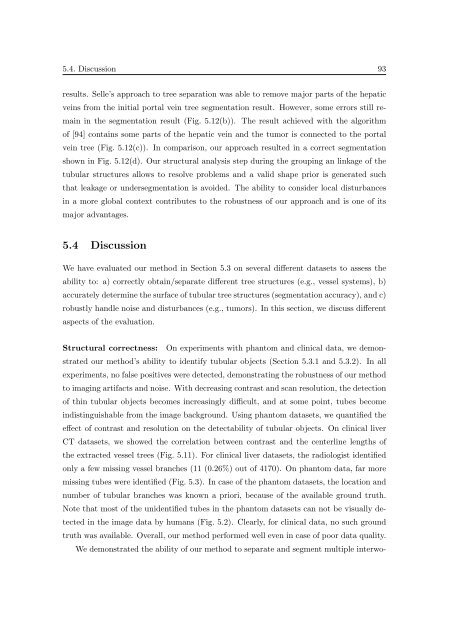Segmentation of 3D Tubular Tree Structures in Medical Images ...
Segmentation of 3D Tubular Tree Structures in Medical Images ...
Segmentation of 3D Tubular Tree Structures in Medical Images ...
Create successful ePaper yourself
Turn your PDF publications into a flip-book with our unique Google optimized e-Paper software.
5.4. Discussion 93<br />
results. Selle’s approach to tree separation was able to remove major parts <strong>of</strong> the hepatic<br />
ve<strong>in</strong>s from the <strong>in</strong>itial portal ve<strong>in</strong> tree segmentation result. However, some errors still rema<strong>in</strong><br />
<strong>in</strong> the segmentation result (Fig. 5.12(b)). The result achieved with the algorithm<br />
<strong>of</strong> [94] conta<strong>in</strong>s some parts <strong>of</strong> the hepatic ve<strong>in</strong> and the tumor is connected to the portal<br />
ve<strong>in</strong> tree (Fig. 5.12(c)). In comparison, our approach resulted <strong>in</strong> a correct segmentation<br />
shown <strong>in</strong> Fig. 5.12(d). Our structural analysis step dur<strong>in</strong>g the group<strong>in</strong>g an l<strong>in</strong>kage <strong>of</strong> the<br />
tubular structures allows to resolve problems and a valid shape prior is generated such<br />
that leakage or undersegmentation is avoided. The ability to consider local disturbances<br />
<strong>in</strong> a more global context contributes to the robustness <strong>of</strong> our approach and is one <strong>of</strong> its<br />
major advantages.<br />
5.4 Discussion<br />
We have evaluated our method <strong>in</strong> Section 5.3 on several different datasets to assess the<br />
ability to: a) correctly obta<strong>in</strong>/separate different tree structures (e.g., vessel systems), b)<br />
accurately determ<strong>in</strong>e the surface <strong>of</strong> tubular tree structures (segmentation accuracy), and c)<br />
robustly handle noise and disturbances (e.g., tumors). In this section, we discuss different<br />
aspects <strong>of</strong> the evaluation.<br />
Structural correctness: On experiments with phantom and cl<strong>in</strong>ical data, we demonstrated<br />
our method’s ability to identify tubular objects (Section 5.3.1 and 5.3.2). In all<br />
experiments, no false positives were detected, demonstrat<strong>in</strong>g the robustness <strong>of</strong> our method<br />
to imag<strong>in</strong>g artifacts and noise. With decreas<strong>in</strong>g contrast and scan resolution, the detection<br />
<strong>of</strong> th<strong>in</strong> tubular objects becomes <strong>in</strong>creas<strong>in</strong>gly difficult, and at some po<strong>in</strong>t, tubes become<br />
<strong>in</strong>dist<strong>in</strong>guishable from the image background. Us<strong>in</strong>g phantom datasets, we quantified the<br />
effect <strong>of</strong> contrast and resolution on the detectability <strong>of</strong> tubular objects. On cl<strong>in</strong>ical liver<br />
CT datasets, we showed the correlation between contrast and the centerl<strong>in</strong>e lengths <strong>of</strong><br />
the extracted vessel trees (Fig. 5.11). For cl<strong>in</strong>ical liver datasets, the radiologist identified<br />
only a few miss<strong>in</strong>g vessel branches (11 (0.26%) out <strong>of</strong> 4170). On phantom data, far more<br />
miss<strong>in</strong>g tubes were identified (Fig. 5.3). In case <strong>of</strong> the phantom datasets, the location and<br />
number <strong>of</strong> tubular branches was known a priori, because <strong>of</strong> the available ground truth.<br />
Note that most <strong>of</strong> the unidentified tubes <strong>in</strong> the phantom datasets can not be visually detected<br />
<strong>in</strong> the image data by humans (Fig. 5.2). Clearly, for cl<strong>in</strong>ical data, no such ground<br />
truth was available. Overall, our method performed well even <strong>in</strong> case <strong>of</strong> poor data quality.<br />
We demonstrated the ability <strong>of</strong> our method to separate and segment multiple <strong>in</strong>terwo-















